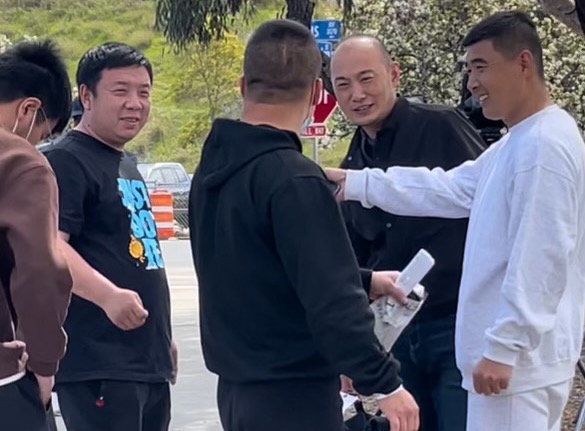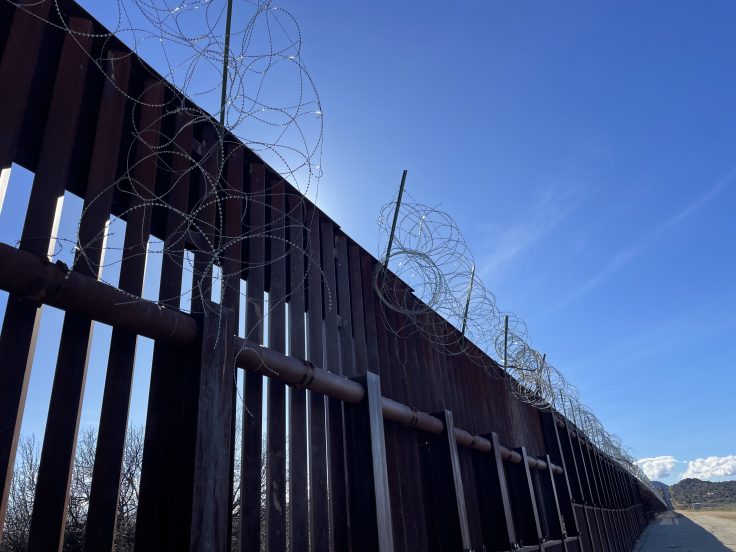JACUMBA HOT SPRINGS, Calif.—On a sunny Thursday afternoon in February, a family of four in designer-branded clothes wait for a ride from the California border near Jacumba Hot Springs, a tiny desert town 70 miles east of San Diego.
They had just climbed through the man-sized wire hole at San Judas Break, where California’s border wall meets a hill of boulders. The husband pushed a baby in a stroller. The wife, well coiffed and carrying a Michael Kors purse, dragged a roller suitcase—as did the teenaged son in pristine white platform tennis shoes and a Tommy Hilfiger sweatsuit. They had apparently been delivered by their smugglers—or as one sympathetic advocate called them, "travel agents"—to the gap. Soon a border patrol agent arrived with a van, loaded up their luggage, helped them with their seatbelts, and drove them to a nearby station. From there, the family would be shuttled to San Diego courtesy of the U.S. government.

- A family of four awaits their ride to a nearby border patrol station for processing after climbing through a hole at San Judas Break, Jacumba Hot Springs (Maurna Desmond)
This family, which would not agree to use a translator app to speak to the Washington Free Beacon, was among the few to breach that particular gap over the past few weeks, according to interviews with border agents. As recently as last month the barbed-wire hole—at the end of a massive wall built by two former presidents—was a favorite drop-off spot for human smugglers. It became a viral media embarrassment for President Joe Biden thanks to X and a CBS 60 Minutes show as hundreds of Chinese men streamed through. Now it’s blocked by the Mexican military.
And while fixing the gap seems like it would be easy, federal border agents told the Free Beacon U.S. officials aren't allowed to do anything about it due to Biden’s order to stop all border wall construction. What they can do is supply porta potties and dumpsters for immigrants who have crossed over illegally, even if the heaps of trash indicate that not everyone uses the dumpsters.
"The whole world knows they can come in," one border agent said, describing the flight paths various nationalities take to Mexico City and Tijuana. Chinese nationals, for instance, who are crossing the border illegally at a record pace, fly through Japan and South Korea so Mexico will accept their passports. In the sanctuary state of California, the official said, "they almost get a hug."
Some border agents, who spoke to the Free Beacon on condition of anonymity, expect Jacumba Hot Springs to see a rise in border jumpers as Texas cracks down on its own illegal immigration problems. Texas has sent state troops to arrest those suspected of crossing illegally and seized a well-trafficked section of the border to stop the feds from cutting razor wire meant to deter illegal entries. The state's crackdown has shifted coyote smuggling to California and Arizona.
Texas is taking action in the absence of federal support to curb illegal crossings. Amid cratering public trust over his administration’s handling of immigration, Biden claims he can’t do anything to stem immigration without congressional reforms, but through hundreds of executive orders, he ended many of former president Donald Trump’s immigration actions, such as COVID-era restrictions and the "Remain in Mexico" policy which required asylum seekers to stay in Mexico until their immigration court hearing. Biden has ordered officials to release those who cross the border illegally into the United States, in direct contrast to Trump’s asylum restrictions. A CBP spokesperson pointed to the spike in unlawful entries—about 8.5 million since Biden took office—and said they speak for themselves.
Many of these border crossers represent a sea-change from the past, when illegal immigrants were mostly impoverished people from Mexico and Latin America who arrived starving and sick—doing their best to avoid authorities so they could sneak into the United States for under-the-table work.
Brian Jones, California Republican senate minority leader who represents areas along the San Diego border, noted this shift and described how they’ve been replaced by middle-class and even upper middle-class nationals from China, India, and other countries who present themselves to federal agents for ready release into the country.
"When [the immigrants] arrive they’re very well dressed, some in designer clothes and shoes," Jones added.
The trend Jones described was reflected in San Diego Friday afternoon, as border patrol officials bused illegal immigrants to a bus depot where nonprofit workers and volunteers guided them to Ubers, trams, and NGO-chartered buses. Stylish Colombians and Brazilians talked and laughed and texted on their iPhone 15s. One man wore a Gucci belt buckle. A group of Chinese men in their 30s and 40s joked and smoked cigarettes. The change is such a drastic break from the past that official numbers don’t break down the country of origin for most of the current border crossers because they only classify those from Mexico, Guatemala, Honduras, and El Salvador. That’s in keeping with historical norms, but the tracking system hasn’t been updated to account for the new status quo.

- A group of Chinese nationals joke among themselves at a San Diego bus station after being dropped off by U.S. Customs and Border Patrol (Maurna Desmond)
For the past few weeks, the Jacumba Hot Springs gap has seen a decline in immigrants coming in. That’s partially because Mexican soldiers have been posted on their side of the border in three large white tents, equipped with propane tanks, a generator, and water totes. U.S. agents said their presence has mostly deterred people from this particular spot. But coyotes working with cartels and other crime groups, who smuggle immigrants in for fees as high as $30,000, have simply moved their drop-off locations to two less-accessible breaches along the same stretch.
Border agents said they’ve been seeing 60 to 80 people per day in their area, instead of the 400 to 500 per day in December. This slump is reflected in the latest official numbers, which for January show an average of 797 illegal crossings per day in the San Diego region, down from the peak average of 1,100 per day in December. But even with this downturn in unlawful entries, the numbers remain higher than those in prior administrations.
Bob Walsh, a volunteer with San Diego Refugee Forum who has spent hundreds of hours speaking with immigrants from all over the world, says he sees the undisclosed deal with Mexico as "just another opportunity for extortion," noting that many people told him Mexican law enforcement asked them for payoffs to let them get to the border. They paid and were able to cross.
Walsh projects that about half of the immigrants he’s spoken to are escaping violence, danger, or oppression, while the rest say they’re coming for economic reasons or more freedom. The refugees primarily hail from Africa and Afghanistan—the most extreme example being a Guinean man with a scarred head and arms. He also encounters the well-dressed middle-class immigrants. He gave a ride to "sophisticated" men from Turkey headed for a downtown San Diego hotel, who though they crossed illegally wanted to work high-paying Silicon Valley jobs for a few years before returning home. For the pro-immigration NGOs who get hefty contracts to help illegal immigrants, it’s become a contentious matter to differentiate between asylum claimants.
But simply claiming asylum doesn’t give an illegal immigrant authority to work, Walsh said. The channels can be complicated, and it’s unclear how the millions of people entering the United States this way will support themselves in the meantime—leading to cities like New York shelling out billions to keep them afloat and even small towns like Whitewater, Wis., falling into a budget hole after an immigrant influx overtaxed its services.
On the U.S. side, nothing has changed to make illegal crossings less appealing. Border patrol "continues to surge personnel, transportation, processing, and humanitarian resources to the most active and arduous areas throughout San Diego’s border region where migrants are callously placed by smuggling organizations," according to a CBP spokesman.
In practice, border patrol agents function as taxi drivers to anyone who crosses illegally and claims asylum—loading immigrants' luggage into vans and then delivering, after processing, them to a San Diego bus depot where volunteers and NGO workers secure them trams, Ubers, or chartered buses to the airport.
Faced with voter discontent and poor optics, Biden is talking tougher about the border and teasing tighter rules for asylum claimants. Voters have named immigration as the nation’s top problem, and a majority favor building a border wall according to a Monmouth University poll this week. Seventy percent of Californians, typically supportive of immigration, see it now as a crisis or very serious problem. Biden last week teased stricter asylum policies through a potential executive order that’s still under review. He visited the Texas border on Thursday near Brownsville, which is represented by a Democrat, in a photo-op trip to coincide with Trump’s appearance at Eagle Pass—a popular illegal crossing spot in Texas. In remarks, he blamed the border crisis on Republicans who killed the latest immigration bill and urged Trump to join him in lobbying Congress to pass it.
